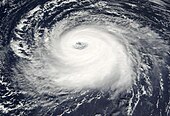Our website is made possible by displaying online advertisements to our visitors.
Please consider supporting us by disabling your ad blocker.
Tropical cyclone naming
| Part of a series on |
| Tropical cyclones |
|---|
 |
|
Outline Media coverage |
Tropical cyclones and subtropical cyclones are named by various warning centers to simplify communication between forecasters and the general public regarding forecasts, watches and warnings. The names are intended to reduce confusion in the event of concurrent storms in the same basin. Once storms develop sustained wind speeds of more than 33 knots (61 km/h; 38 mph), names are generally assigned to them from predetermined lists, depending on the basin in which they originate. Some tropical depressions are named in the Western Pacific, while tropical cyclones must contain a significant amount of gale-force winds before they are named in the Southern Hemisphere.
Before it became standard practice to give personal (first) names to tropical cyclones, they were named after places, objects, or the saints' feast days on which they occurred. Credit for the first usage of personal names for weather systems is generally given to Queensland Government meteorologist Clement Wragge, who named systems between 1887 and 1907. When Wragge retired, the practice fell into disuse for several years until it was revived in the latter part of World War II for the Western Pacific. Formal naming schemes and lists have subsequently been used for major storms in the Eastern, Central, Western and Southern Pacific basins, and the Australian region, Atlantic Ocean and Indian Ocean.
Previous Page Next Page
Llista de noms dels ciclons tropicals Catalan Liste der Namen tropischer Wirbelstürme German Nombres de los ciclones tropicales Spanish نامگذاری چرخند حارهای FA Nomenclature des cyclones tropicaux French Lista de furacáns GL उष्णकटिबंधीय चक्रवात के नामों की सूची HI Daftar nama siklon tropis ID 台風の名前 Japanese 열대 저기압의 이름 Korean


